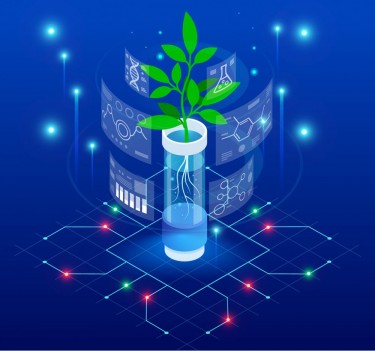What is Cannabis Micropropagation and Why is It Important?

Micropropagation is a fantastic technique that helps plant growers produce a large amount of new plants without requiring as many parent plants.
With the benefits of micropropagation, growers are able to enjoy larger yields of the same plants with the same predictable characteristics. This technique has been used by nurseries and agricultural businesses for a long time now, though the very same fundamentals behind it can also benefit the cannabis industry.
Recently, research conducted by investigators from UConn analyzed the feasibility of cannabis micropropagation with the hemp plant. The results, which were published in HortTechnology and discussed in Lancaster Farming, shed light on current production challenges especially when it comes to medical cannabis.
“Micropropagation produces many more clones than other methods. Since it is not relying on seed, the clones are uniform, and they will perform similarly to the parent plant. Plants that come out of tissue culture also have the benefit of being disease-free, they frequently show enhanced vigor, and you can grow a lot more in less space,” explains associate professor Jessica Lubell-Brand, Ph.D.
With other plants, micropropagation has proven to be easy because growers who are responsible for providing growth hormones and nutrients to the plants in tissue culture, as well as regulate light and temperature can already ensure that the yield production will be predictable. But with cannabis, this process needs some adjustments in order to ensure that health plants are produced. “Cannabis does not really want to be in tissue culture. This research is a lot of trying to figure out, ‘What more does the plant need,” explains Lubell-Brand.
“We start the culture using shoot tips from greenhouse-grown plants,” she adds. “Then we subculture those and if we suspect something is lacking, for instance, that the plant isn’t getting what it needs in the media, we experiment with nutrients like calcium, magnesium, phosphorus and nitrogen to try to increase the length of time that they grow in culture.”
She goes on to say that with cannabis, they noticed hyperhydricity of the shoots which causes problems with growth. Because of this they have to adjust the media used during the first 6 weeks but they also added the use of vented vessels for improved air flow, solving hyperhydricity.
“In addition to creating large quantities of clones of the parent plant, micropropagated plants will very likely show enhanced growth vigor compared to conventional stem propagated plants,” she says.
Researcher and student Lauren Kurtz says that she plans to study it more in the future and learn how to refine the process especially in finding out the right timing for rooting, and how long shoots can stay in culture. “Tissue culture is not that well worked-out for cannabis in the literature,” Kurtz says. “People are aware of the complications, problems and downfalls, so people have been pretty receptive to the paper.”
“Despite all our efforts, it’s still not easy to grow cannabis in tissue culture,” she adds. “However, now we can multiply shoots, root shoots, and transition them from the lab to the greenhouse, which is a step forward.”
Why is Cannabis Micropropagation Important?
Conventional knowledge of cannabis growing, or other types of plants for that matter, is that they all begin from seed. The seeds are then placed in a moist soil which has been aerated in order to induce germination, and exposed to fluorescent light.
While this is the standard method of growing cannabis plants, there are many disadvantages for cannabis growers who continue using seed. For one, the plants will keep reproducing seeds with unstable genetics and another is that there’s a 50% chance that you will get male plants unless you use feminized seeds. Additionally, you’ll also have to wait a longer period of time for the plants to ripen, and last but not least, there’s a good chance that you’ll waste several seeds because they won’t germinate.
Here’s why it’s important for researchers to find a way to micropropagate cannabis:
-
It preserves plant genetics: Anyone in the cannabis industry can tell you that there’s a pretty good chance that two Blue Dream strains obtained from two different dispensaries are not going to produce exactly the same results with the same person. That’s because each cannabis seed has its own genetic composition and there are far too many factors that affect changes in cannabis plant growth, resulting in varying effects.
Micropropagation will reduce the impact of that happening because the plants yielded ensure to be a good genetic copy of the cannabis media that was used.
-
It optimizes plant growth: Though it certainly requires much more effort to grow cannabis through micropropagation, it will be worth it because the plants grown from it will have world-class genes and they’ll also be growing in a much quicker time. In other words, it will help growers generate profit quickly because there’s a seriously big demand these days.
-
Disease prevention: Poor cultivation practices cause diseases that start from the seed. As a result they suffer from major crop losses. Hemp and cannabis growers can face the risk of losing millions of dollars unless they have a big supply of reliable, disease-free CBD hemp plants that can produce consistent cannabinoid levels and growth.
This all points back to quality and predictability once again, which is why there are more cannabis growers who are expressing interest in micropropagation.
Given the many challenges faced by growers, micropropagation is a good solution for providing genetic stability for plants. It will help them breed strains and have consistent results across certain traits that they want to be prominent while ensuring the plants are free from disease, all while being able to mass produce plants at scale.






